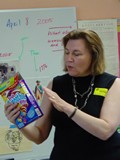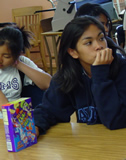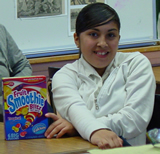CML Pilots Media Literacy Unit for Obesity, Nutrition Education
|
|
Students increase nutrition savvy by 16%
Childhood obesity may be a growing national health crisis but for 19 students at Sepulveda Middle School in Los Angeles, a three-week pilot media literacy / nutrition program in spring 2005, provided them with plenty of food for thought about how media and pop culture image a healthy diet.
Moreover, pre and post test results revealed that the group of 19 young people increased their nutrition savvy by 16%, jumping from 79% to 95%.
What's more, while sharpening their own media literacy and nutrition skills, they also created a teaching tool that enlightened their schoolmates. A control group of 42 students at Sepulveda showed an increase of 9% in understanding on the same tests, just from watching a 10-minute video made by their peers.
Five Key Questions provide framework 
Commissioned by the Nutrition Network (Nut Net) of the Los Angeles Unified School District , the program was designed by CML to teach media literacy skills while students also learned about the key ingredients of a healthy diet. CML's MediaLit Kit™ with its Five Key Questions of Media Literacy served as the framework for the lessons.
The Nutrition Network is funded by the USDA Food Stamp Program to encourage low-income students to eat more fruits and vegetables.
"The toughest part isn't getting the information about healthful eating into students' heads," says Nut Net Consultant Beth Larsen, "It's getting the information into their hearts so they make better decisions because they want to, not because they are told to."
Larson noted that the most important goal of the program was to inspire students, not just inform them and commented that the media literacy inquiry skills in "A Recipe for Action" added just what was needed. "The program brought a different perspective, a deeper level of understanding and meaning to our students," she explained.
Video is culminating activity
The three-week program had the group of 19 middle-schoolers analyze a 30-second commercial for General Mills' "Fruit Smoothie Blitz" fruit snack. It features a group of children enjoying the snack as they play outside, while their neglected blender sulks and whirrs from the kitchen window.
The students, all members of Sepulveda's "Leadership Class," watched the spot repeatedly, learning about what goes into making advertisements about food products and how the message of the ad was constructed. They also tested the snack themselves, decoded the nutrition label and learned about all the requirements for proper nutrition.
Finally, they put on their "reporter" and "producer" hats and interviewed each other for a simple 10-minute video, which they screened to 42 control group students in a P.E. class. For many, making a video was the highlight of the classes which met daily for the three weeks. Asking "what did you learn?" students commented:
"I learned how advertising really works. I learned about the Five Key Questions, which [are] always going to be in my head."
"I learned to not just watch and believe the commercials but to look at nutrition facts on the products."
"I learned that when I see an ad, I have to ask myself the Five Key Questions."
Other student comments reflected the significant shift in their understanding of nutrition, demonstrating that they now know the difference between a sugary "smoothie" snack and the real deal.
In June, Larsen and CML president Tessa Jolls presented the program and its findings at the 2005 National Media Education Conference in San Francisco. Recognizing that even though the program was short and the research informal, Larsen was "thrilled" with the program design and the outcomes achieved.
"Ultimately…student desires and habits changed because they saw for themselves how media messages were shaping many of their unconscious decisions and decided, on their own, to make positive changes," she said, adding that the Nutrition Network and CML will be expanding the pilot in 2006.
Children and teens clearly need better, more specific nutrition tips than "you are what you eat," Larsen further explained. " CML's Media Literacy: A Recipe for Action provided the crucial tools to help them become enlightened consumers of both food and media."
Photographs by Allison Jolls





